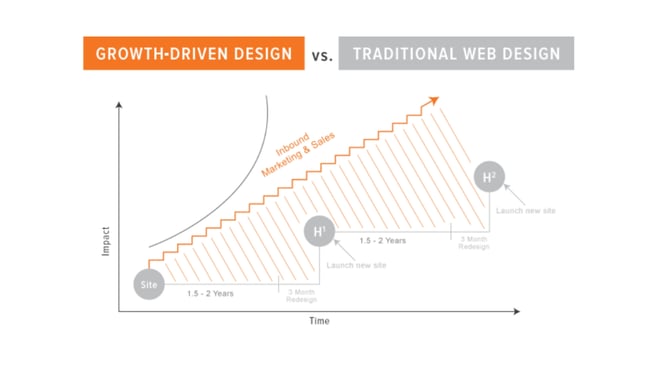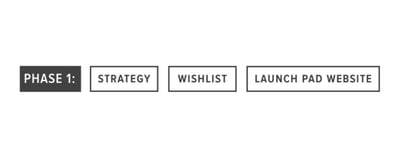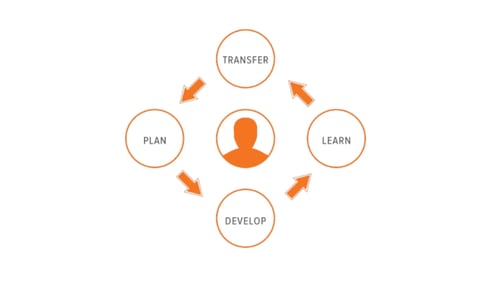What Is Growth Driven Design? And Why Everyone Should Be Doing It
As the CEO and founder of a marketing agency and consulting firm, this is a question that I get asked all too often by my clients. But before I can answer what it is, it is vital for me to define its importance and the crucial role Growth Driven Design can play in your business.
As you know, it’s a truth universally acknowledged that there has been a fundamental shift in the balance of power between companies and consumers. Before the advent of technology, companies were able to control the narrative they fed to a consumer and influence them to buy into a sales process and image that they carefully crafted. They held all the strings with a consumer at the whim of their mercy.
Now, with the digitization of our society, consumers feel more confident than ever before to advocate for themselves in their buyer's journey and make a purchase on their terms. But what has changed? In short, the way consumers search and access information. They gain awareness by scrolling through their Instagram feed on their iPhone and have their interest peaked by a thump stopping post. After a fruitful Google Search they opt-in to receive a free eBook to educate themselves on solving a potential pain point or problem. And over time they compare and contrast competitors, empowered by their research, to conclude their journey and make their final purchase decision.
So, what does this have to do with Growth Driven or Traditional Web Design? Everything. Because your website is the pinnacle of your marketing mix. It is where consumers will go to find out more about your products or services and where they begin to vet if you are worth their hard earned dollars. Not only is it an essential marketing asset, but it is your businesses hardest working salesperson.
According to Luke Summerfield, Partner Services Program Manager at HubSpot, "a prospect has already moved through 70% of your sales process before even reaching out to your sales team. Where are they finding this information before talking to someone? Your website." And it begs to ask the question with so much at stake (competition among brands so stiff and highly educated consumers calling all the shots) why the traditional web design process is still being considered as a viable industry standard?
And do you want my pure, honest opinion? It shouldn't be. And here's why:
The traditional web design process is extremely costly, time-consuming, and facilitated without any focus on producing measurable results or providing real value to potential customers.
It lacks agility, often neglecting to recognize constantly shifting consumer behavior and the critical role that data can play in validating your design/development efforts and helping support successful marketing campaigns. Let’s take a deeper dive: using a traditional website process to complete a site “typically costs anywhere between $15,000 - 80,000,” and is usually paid upfront, before any data has been collected to validate your design. Since there is a focus on delivering a complete product, team resources are monopolized and as a result, you often receive a site that is completed past its initial deadline. And worse still, after launch, a typical site “sits with no major updates for 1.5. To 2 years,” which is a total missed opportunity to use your site to your best advantage with your customers.
But there is a better and easier solution for doing things, and that is why I champion Growth Driven Design and believe everyone should be doing it!

So what exactly is Growth Driven Design?
According to Ironpaper, Growth Driven Design is "is agile development or redesign of a website in intentional increments. Making continuous, adaptations based on data, this is not laboring to make every element of your site perfect before leaving it to sit static online for a few years. Instead, you minimize risk by focusing on a data- and audience-analysis driven site launch or re-design intending to make changes based on your ongoing analysis of visitors’ needs and your lead conversions."
It is built on three basic principles: the minimization of risk, the importance of continuous improvement, and the full integration of marketing and sales. It's a smarter, faster, and more cost-effective approach to support your overall business goals and get the results you want for your business.
How does it work? Mainly, two phases make up Growth Driven Design that I will illustrate below.
Phase 1: Growth Driven Design Process

First, the strategy helps to lay the foundation for the Growth Driven Design process. It is a moment to come together as a team and establish S.M.A.R.T goals and have an honest discussion about how your website will support these goals and what KPI's are most important to include. Then you will need to identify and create personas, which are fictional representations of your ideal customer, who will represent potential users of your website.
Next comes research: quantitative and qualitative. If you have an existing website, an audit will provide insight into areas of improvement for your redesign. Leverage existing customers to help you validate areas of opportunity that you have identified during the audit.
These will help you cultivate some fundamental assumptions about users that in turn will help develop your Global and Page Strategy. At this point, you want to be clear about your main goals overall for your website and how each page will support that.
Now it's time to make a wishlist! This is a fun, informal process were your team, and key stakeholders should gather together to generate, as Luke Summerfield suggests "50-150 ideas," for your new website. Don't limit yourself, focus on making sure you have thoroughly considered any and all ideas during this critical brainstorming session.
Now that you have established goals, defined your potential users, conducted research, and have a sizable wishlist you are ready to create your launch pad website! This is a website created without an emphasis on perfectionism. You will rely on the 80/20 rule, where you will prioritize 20% of your wishlist items for the first iteration of your launch pad website. At this point, we want a functional site that can be used to gather user data to validate your hypotheses about users and marketing efforts further.
Phase Two: Growth Driven Design Cycle

Now that your launch pad website is live, you will want to begin planning the next improvement of your site. Again carefully comparing performance against your established goals, adding functionality based your previously found wishlist items. You can focus on improving user experience, conversions or offering a more personalized customer experience. You want to start launching campaigns that will allow you to collect data about your users that will help inform you about what wishlist items to prioritize for the next phase of development. And you want to create systems and processes that support any important discoveries being shared with your team as you move forward with the development process.
In closing, after careful review of the information above, I hope that I have made a point for the importance of embracing growth driven design in your own business. You no longer have to manage large upfront costs, overwork your team and produce a site that does not drive results or align with your business goals. Embrace growth driven design and start cultivating real results for your business!
Topics: Inbound Marketing Digital Marketing Financial Services Marketing Digital Wholesaling Business Development Content is King Financial Services Marketing Automation Wholesalers Growth Driven Design
Stay in Touch
Subscribe to our email newsletter
Posts by Tag
- Business Development (25)
- Buyer Persona (11)
- Buyers Journey (5)
- Case Study (2)
- Content is King (25)
- Digital Marketing (75)
- Digital Wholesaling (35)
- Financial Services (19)
- Financial Services Marketing (57)
- Growth Driven Design (15)
- Inbound Marketing (76)
- Inbound vs. Outbound (10)
- Internal Wholesaler (2)
- Marketing Automation (18)
- Robo-Wholesaling (1)
- Sales (6)
- Sales Enablement (12)
- SEO (3)
- Wholesalers (17)

